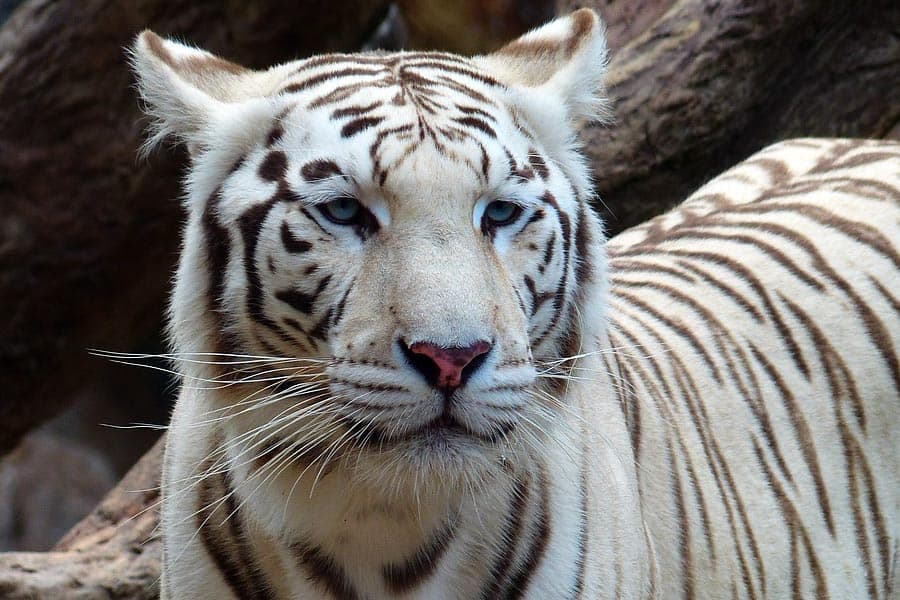White Bengal Tiger Information and Facts
If any creature could lay claim to folkloric origin, it is surely the white tiger. With their ghostly coloring and startling blue eyes, it’s no wonder they have become popular icons for merchandise and school mascots. However, there’s more science than mythology behind the white tigers’ origin.
White tigers are not their own species but are actually Bengal tigers with a recessive genetic trait that alters their coloring from bright orange to mystic white. These white Bengal tigers are sometimes mistakenly called “albino,” however, the presence of black stripes, as well as black pigment in their eyes, bars them from being true albinos. Instead, white Bengal tigers are actually “leucistic,” meaning they lose pigmentation in their skin and fur. This genetic trait is extremely rare, only occurring in an estimated 1 out of 10,000 tigers.
White Siberian Tigers
Although Siberia is synonymous with snow, Siberian tigers (or Amur tigers) don’t actually have snowy, white coats. However, they do have the lightest orange coat of the tiger subpopulations, and they become especially pale in winter.
While “Siberian white tiger” is a misnomer, the Siberian tiger still has a connection to the real, white Bengal tigers. Siberian tigers are sometimes crossbred with Bengal tigers as it is believed to increase the chances of producing white cubs. In reality, what is really being produced are generations of “generic” tigers who have no conservation value because they do not belong to a pure subspecies. Crossbreeding the Siberian and white Bengal tigers also results in a plethora of genetic problems and is a practice that should be condemned by true conservationists.
Wild White Bengal Tigers
The earliest record of a white tiger dates back to 16th century India. Between 1807 and 1958 there were over fifty sightings of white Bengal tigers in the wild. Sadly, these encounters often ended in the capture or death of the white tigers, and with their genetic occurrence already a rarity, they soon vanished from the wild. The tiger shot in 1958 is believed to have been the last wild, white Bengal tiger.
Captive White Bengal Tigers
Although white Bengal tigers no longer roam through Indian jungles, a small population still survives in captivity.
The white tigers seen in zoos today all stem from a single cub captured by Maharaja Martand Singh in 1951. The cub was named Mohan, and his entire, orange-furred family was killed just so he could be captured.
Initially bred with an unrelated orange tiger, Mohan produced several orange cubs, but no white ones. In order to obtain more white cubs, Mohan was then bred with his own, orange daughter. One resultant white cub was brought to the United States and became the founder of the captive and breeding population here.
White Bengal tigers are continually bred for the same reason they had been hunted: they are beautiful and rare, and therefore seen as extremely valuable. Indeed, white Bengal tigers became a main attraction in “show biz” thanks to Siegfried & Roy, a pair of magicians who used white tigers and other animals in their extravagant Las Vegas show. However, Siegfried & Roy were adamant their animals were not exploited, and were active in conservation efforts for several endangered species, especially white tigers.
White Bengal tigers have been bred with each other to increase captive populations, and numbers have soared from only a dozen in the 1970s to hundreds today. However, the question must be asked: is this truly conservation?
White Bengal Tiger Conservation & Criticism
While one might think the issue of conservation would be as black and white as the tigers themselves, it’s actually a grey area and heavily debated.
Those who argue for the conservation of white Bengal tigers, which happens through continued breeding, believe “white tigers are part of the natural genetic diversity of their species,” therefore, “we humans should consider saving them. Well-managed captive populations of wild animals have proved to be valuable assets in education, research and fund-raising.”
Some white tiger conservation advocates seek not only to maintain a captive population, but also wish to see white tigers reintroduced into the wild. They argue that “these genes are conserved even in captivity and have, therefore, an inherent right to survive in the wild.”
However, such conservation efforts have been widely condemned for several key reasons, including the same genes that are lauded by the would-be white tiger conservationists.
While white Bengal tigers might gain a majestic fur coat from their genetic mutation, they also suffer from a menagerie of health problems. The white coat itself can even be a problem, preventing much needed camouflage for this natural predator.
One of the most common problems is crossed eyes, even in white tigers who don’t look particularly cross-eyed. “The same gene that causes the white coat causes the optic nerve to be wired to the wrong side of the brain, thus all white tigers are cross eyed, even if their eyes look normal.” This abnormal visual connection “probably means that the mutation did affect the white tigers’ survival in the wild.”
Other severe health problems observed in white Bengal tigers include cleft palates, club feet, defective organs, kidney problems, and hip dysplasia. The Turpentine Creek Wildlife Refuge rescued a white tiger named Kenny whose face was so deformed due to inbreeding, visitors compared him to a bulldog. Although tigers can live into their twenties, “Kenny died from an aggressive form of skin cancer eight years after his rescue, at the young age of 10.” Turpentine Creek Animal Curator, Emily McCormack, said education was the key to ensuring other white Bengal tigers didn’t suffer like Kenny.
How You Can Help
White Bengal tigers are “so inbred that they will never be suitable for reintroduction to the wild.” This means there is no real hope, or reason, to expend effort conserving this nonexistent species. In fact, such efforts syphon funds and resources away from legitimate breeding programs for endangered subspecies such as the Sumatran and Siberian tiger, or even healthy, orange Bengal tigers.
Indeed, Dan Laughlin, DMV, PhD, put it bluntly when he said, “In my view, exhibiting and breeding white tigers is the very antithesis of conservation, is dishonest and unethical and is tantamount to catering to the public’s desire to see genetic aberrations rather than educating the public regarding the incredible process of natural selection.”
In 2011, the Association of Zoos and Aquariums banned member zoos from the breeding of white tigers. This was a step in the right direction, not only preventing a growing population of unhealthy white Bengal tigers but also redirecting focus to tigers who have true conservation value.
You can help, too! Money talks: you can make a difference by refusing “to patronize facilities that breed white tigers, allow cub petting, use them for entertainment, or keep them for personal pets.” This discourages further breeding and helps prevent existing white tigers from exploitive abuse.
You can also directly contribute to legitimate tiger conservation efforts through donations to big cat sanctuaries that have been accredited by the Global Federation of Animal Sanctuaries or purchasing digital products right here from Project Endangered Tigers!
The current population of white Bengal tigers certainly deserves to be well-cared for but should not be propagated. It is time for the ghostly white tiger to pass peacefully from memory into a phantom of history, allowing the remaining, truly endangered tigers to burn all the brighter in a blaze of orange.
Save Tigers Live HD Wallpaper App & Screensaver
Screensaver and app sales benefit tiger conservation
WildCats Conservation Alliance is a wild tiger and Amur leopard initiative that funds carefully chosen conservation projects across Asia, working with a range of national and international conservation NGOs. It is a partnership between the Zoological Society of London (UK charity # 208728) and Dreamworld Wildlife Foundation (ACNC # 61150274463)’.
Screensaver Requirements
App Requirements





Once payment is made, you can download the screensaver and app immediately. The Android app can be downloaded directly from our website and includes a code to unlock the app. We have chosen not to include our app in the Google Play Store because of the very high fees Google charges.
Works Cited
“Amur Tiger Facts,” Wildcats Conservation Alliance, accessed April 15, 2021,
https://conservewildcats.org/resources/amur-tiger-facts/.
Drummond, Leanne. “Records of White Tigers in the Wild,” Scribd, August 1, 2015,
https://www.scribd.com/document/273205215/Records-of-White-Tigers-in-the-Wild.
Landers, Jackson. “Why White Tigers Should Go Extinct,” Slate, December 13, 2012,
https://slate.com/technology/2012/12/white-tiger-controversy-zoos-shouldnt-raise-these-
inbred-ecologically-irrelevant-animals.html.
Laughlin, Dan. “The White Tiger Fraud,” Big Cat Rescue, January 11, 2019,
https://bigcatrescue.org/the-white-tiger-fraud/.
Lou, Shu-Jin & Xiao Xu. “Save the White Tigers,” Scientific American, October 16, 2014,
https://www.scientificamerican.com/article/save-the-white-tigers/.
McFadden, Robert D. “Roy Horn, Who Dazzled Audiences as Half of Siegfried & Roy, Dies at
75,” New York Times, May 8, 2020, https://www.nytimes.com/2020/05/08/obituaries/roy-
horn-dead-covid.html.
Rouse, Sabina & Alison Maloney. “Cruel For Cats: Kenny the £30,000 inbred white tiger born in
cruel bid to make cash—and the terrifying trade of big cats,” The Sun, January 10, 2019,
https://www.thesun.co.uk/news/7959952/kenny-inbred-tiger/.
“The Rest of the Story: What 20/20 Left Out Of Their Siegfried And Roy Special,” Turpentine
Creek Wildlife Refuge, October 1, 2019, https://www.turpentinecreek.org/the-rest-of-the-
story/.
“The Surprising Reality of the White Tiger,” Turpentine Creek Wildlife Refuge, accessed April
14, 2021, https://education.turpentinecreek.org/2020/05/01/the-surprising-reality-of-the-
popular-white-tiger/.
“The Truth About White Tigers,” The Wildcat Sanctuary, January 15, 2014,
https://www.wildcatsanctuary.org/the-truth-about-white-tigers/.
“White Tiger Truth,” Big Cat Rescue, accessed April 14, 2021, https://bigcatrescue.org/abuse-
issues/issues/white-tigers/.
Xavier, Nicky K. “A new conservation policy needed for reintroduction of Bengal tiger-white,”
Current Science, vol.99, no.7, pp.894-895, October 10, 2010.
Xiao Xu et al., “The Genetic Basis of White Tigers.” Report, vol.23, no. 11, June 3, 2013,
pp.1031-1035. https://doi.org/10.1016/j.cub.2013.04.054.
Yong, Ed. “Tiger, Tiger, Burning Bright, Just One Gene To Make It White,” National
Geographic, May 23, 2013, https://www.nationalgeographic.com/science/article/tiger-tiger-burning-bright-just-one-gene-to-make-it-white
1 Xiao Xu et al., “The Genetic Basis of White Tigers.” Report, vol.23, no. 11, June 3, 2013, pp.1031-1035. https://doi.org/10.1016/j.cub.2013.04.054.
2 Ibid.
3 “The Surprising Reality of the White Tiger,” Turpentine Creek Wildlife Refuge, accessed April 14, 2021, https://education.turpentinecreek.org/2020/05/01/the-surprising-reality-of-the-popular-white-tiger/.
4 Ibid.
5 “Amur Tiger Facts,” Wildcats Conservation Alliance, accessed April 15, 2021, https://conservewildcats.org/resources/amur-tiger-facts/.
6 “White Tiger Truth,” Big Cat Rescue, accessed April 14, 2021, https://bigcatrescue.org/abuse-issues/issues/white-tigers/.
7 Ibid.
8 “The Truth About White Tigers,” The Wildcat Sanctuary, January 15, 2014, https://www.wildcatsanctuary.org/the-truth-about-white-tigers/.
9. Xiao Xu et al., “The Genetic Basis of White Tigers.” Report, vol.23, no. 11, June 3, 2013, pp.1031-1035. https://doi.org/10.1016/j.cub.2013.04.054.
10. Drummond, Leanne. “Records of White Tigers in the Wild,” Scribd, August 1, 2015, https://www.scribd.com/document/273205215/Records-of-White-Tigers-in-the-Wild.
11. Yong, Ed. “Tiger, Tiger, Burning Bright, Just One Gene To Make It White,” National Geographic, May 23, 2013, https://www.nationalgeographic.com/science/article/tiger-tiger-burning-bright-just-one-gene-to-make-it-white.
12. “White Tiger Truth,” Big Cat Rescue, accessed April 14, 2021, https://bigcatrescue.org/abuse-issues/issues/white-tigers/.
13. Ibid.
14. McFadden, Robert D. “Roy Horn, Who Dazzled Audiences as Half of Siegfried & Roy, Dies at 75,” New York Times, May 8, 2020, https://www.nytimes.com/2020/05/08/obituaries/roy-horn-dead-covid.html.
15. Ibid.
16. Yong, Ed. “Tiger, Tiger, Burning Bright, Just One Gene To Make It White,” National Geographic, May 23, 2013, https://www.nationalgeographic.com/science/article/tiger-tiger-burning-bright-just-one-gene-to-make-it-white.
17. Lou, Shu-Jin & Xiao Xu. “Save the White Tigers,” Scientific American, October 16, 2014, https://www.scientificamerican.com/article/save-the-white-tigers/.
18. Xavier, Nicky K. “A new conservation policy needed for reintroduction of Bengal tiger-white,” Current Science, vol.99, no.7, pp.894-895, October 10, 2010.
19. “White Tiger Truth,” Big Cat Rescue, accessed April 14, 2021, https://bigcatrescue.org/abuse-issues/issues/white-tigers/.
20. Yong, Ed. “Tiger, Tiger, Burning Bright, Just One Gene To Make It White,” National Geographic, May 23, 2013, https://www.nationalgeographic.com/science/article/tiger-tiger-burning-bright-just-one-gene-to-make-it-white (accessed April 13, 2021).
21. “The Surprising Reality of the White Tiger,” Turpentine Creek Wildlife Refuge, accessed April 14, 2021, https://education.turpentinecreek.org/2020/05/01/the-surprising-reality-of-the-popular-white-tiger/.
22. Rouse, Sabina & Alison Maloney. “Cruel For Cats: Kenny the £30,000 inbred white tiger born in cruel bid to make cash—and the terrifying trade of big cats,” The Sun, January 10, 2019, https://www.thesun.co.uk/news/7959952/kenny-inbred-tiger/.
23. “The Rest of the Story: What 20/20 Left Out Of Their Siegfried And Roy Special,” Turpentine Creek Wildlife Refuge, October 1, 2019, https://www.turpentinecreek.org/the-rest-of-the-story/.
24. Landers, Jackson. “Why White Tigers Should Go Extinct,” Slate, December 13, 2012, https://slate.com/technology/2012/12/white-tiger-controversy-zoos-shouldnt-raise-these-inbred-ecologically-irrelevant-animals.html.
25. Ibid.
26. Laughlin, Dan. “The White Tiger Fraud,” Big Cat Rescue, January 11, 2019, https://bigcatrescue.org/the-white-tiger-fraud/.
27. Landers, Jackson. “Why White Tigers Should Go Extinct,” Slate, December 13, 2012, https://slate.com/technology/2012/12/white-tiger-controversy-zoos-shouldnt-raise-these-inbred-ecologically-irrelevant-animals.html.
28. “The Surprising Reality of the White Tiger,” Turpentine Creek Wildlife Refuge, accessed April 14, 2021, https://education.turpentinecreek.org/2020/05/01/the-surprising-reality-of-the-popular-white-tiger/.
Image by Hans Braxmeier from Pixabay




Comment (1)
Barbara August 17, 2021 at 8:16 pm
Great information!